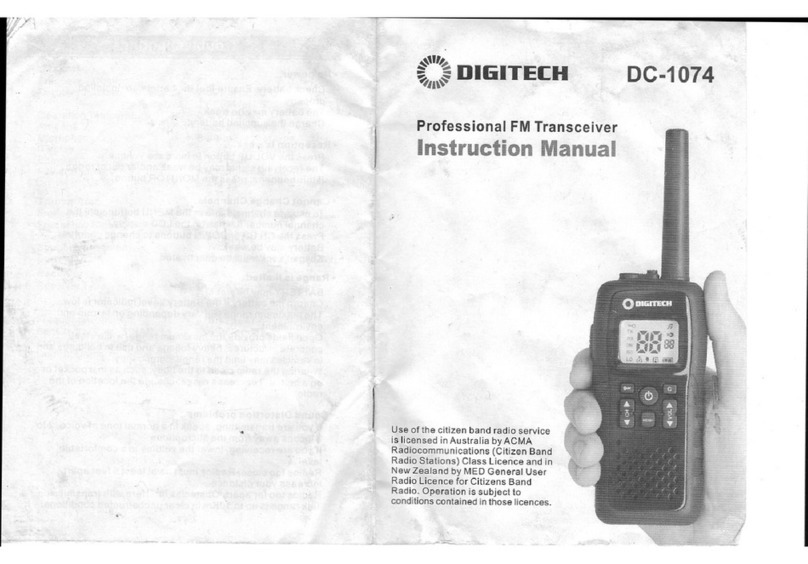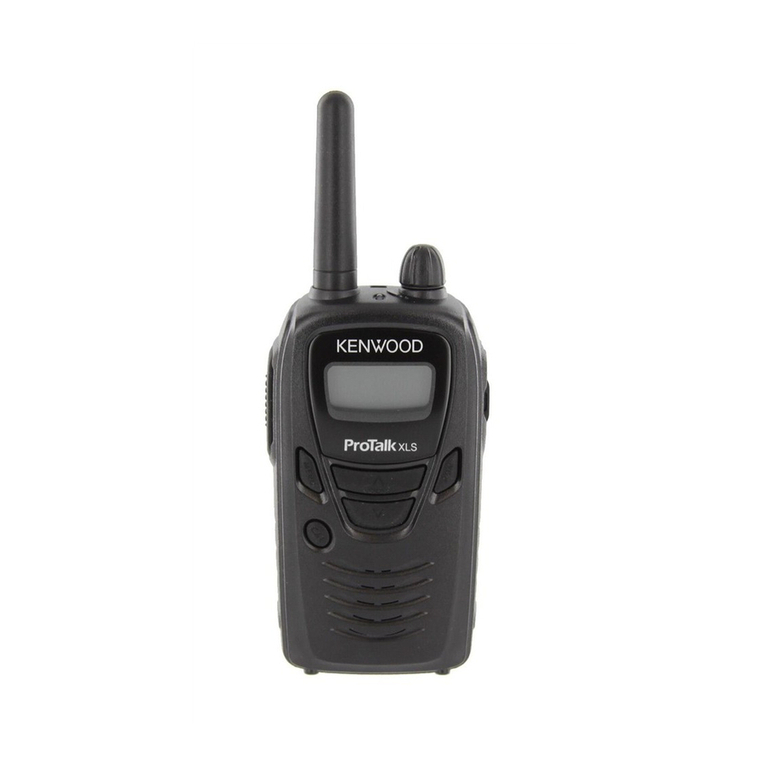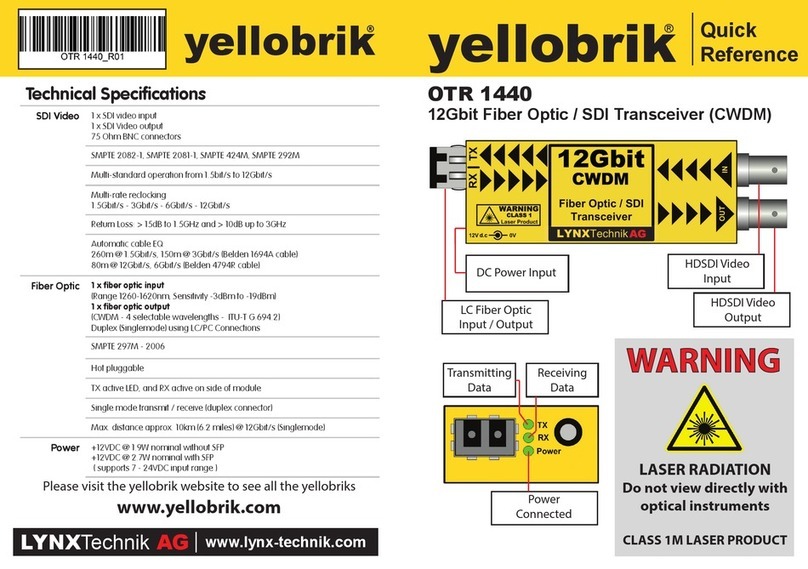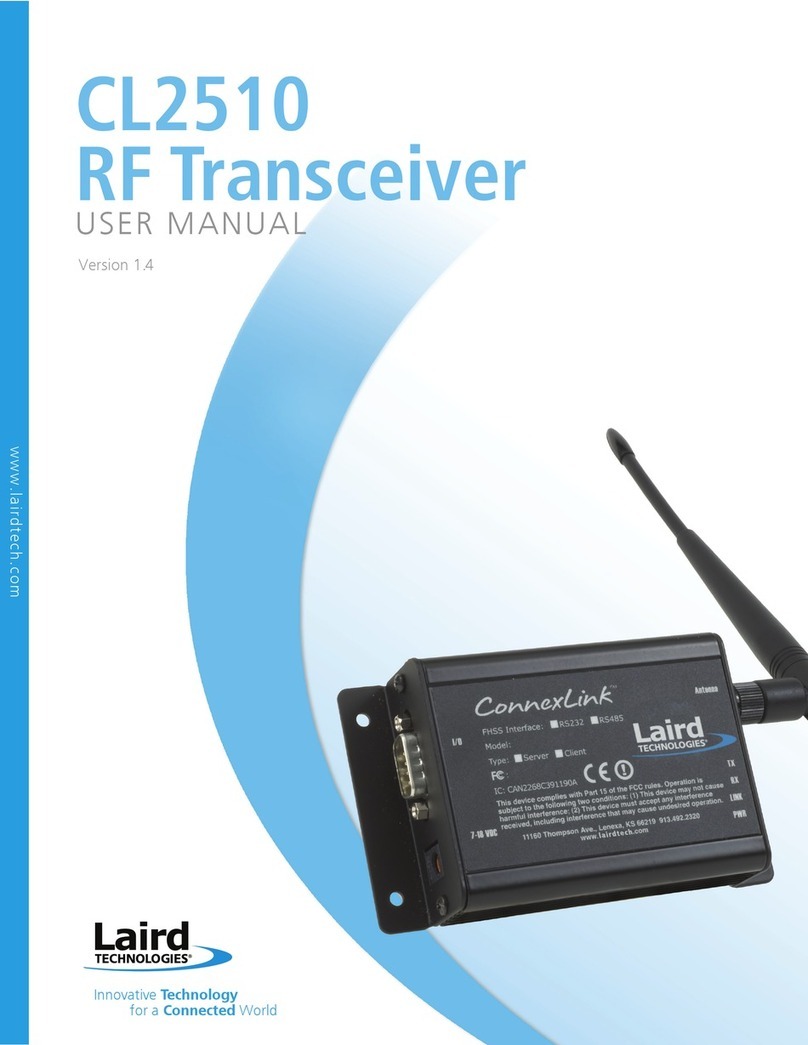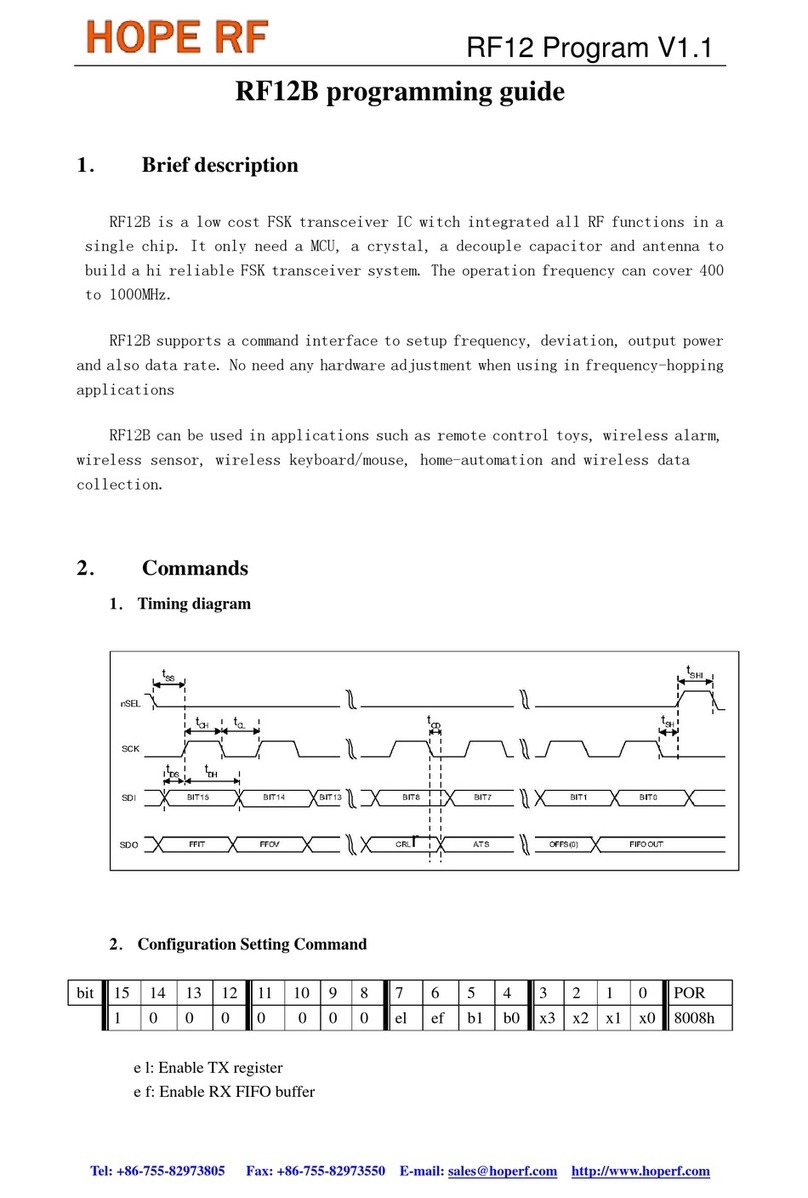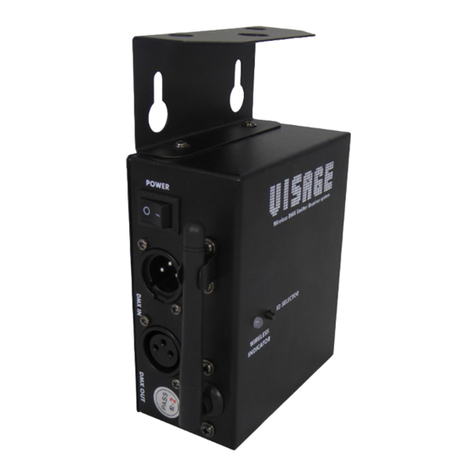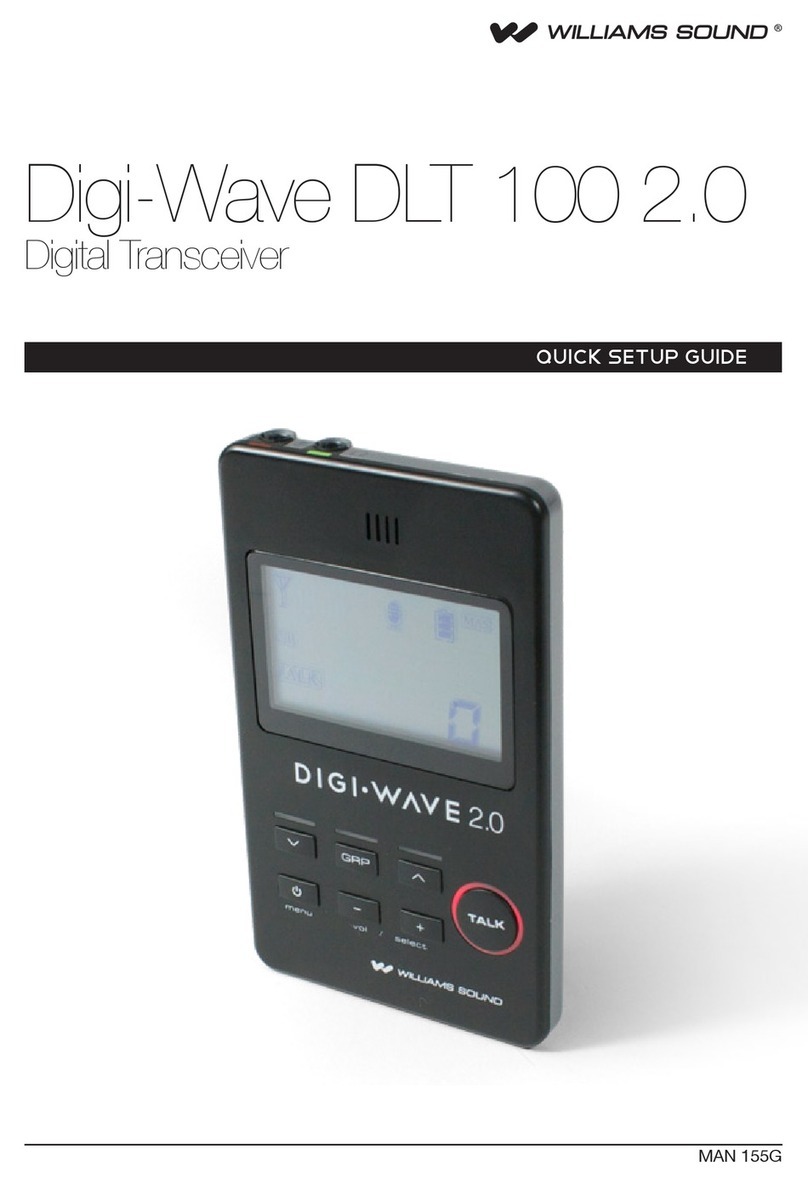digi-tech DC-1122 User manual

Compact 5W
UHF CB Radio
Instruction Manual
DC-1122


Introduction
Use of the citizen band radio service is licensed in Australia by
ACMA Radio communications (Citizen Band Radio Stations)
Class Licence and in New Zealand by MED General User
Radio Licence for Citizens Band Radio. Operation is subject to
conditions contained in those licences.
!
NOTE
Feature
FM transmission
Frequency:476.4250MHz ~ 477.4125MHz
80 channels
5W output power
TOT Timer
38 CTCSS and 104 DCS
100 User Programmable RX Channels
Instant Priority Channel setting
Busy Channel Lockout
Memory store
Call tone melody (10 songs)
Base unit rotary volume
LCD back-light function(3 colours: orange/red/green)
Key back-light
5 step adjustable and automatic squelch function
Repeater function
Key tone function (selectable on/off)
Roger tone function ( selectable on/off)
Dual watch function
Scan channel/Memory scan
-1-

1
3
4
5
6
Base (front & Rear view)
1. MIC Jack
2. Volume knob
3. Main speaker
4. Power Input Connection ( 13.8VDC or 27.6VDC )
5. EXT SP - External Speaker Jack
6. UHF Antenna Connection
Control and Indicators
-2-
EXT.SP.DC 13.8V
DC 27.6V
ANT
2

6
7
8
9
10
11
12
13
14
15
16
17
18
19
20
21
22
23
24
Microphone
6. CALL/SELCALL Button 16.LCD display
7. Push To Talk Button 17.Volume Up
8. Memory Button 18.Volume Down
9. PO/FI and CTCSS/DCS button 19.Memory channel Select and
10.Channel Up Dual Watch Button
11. Scan Button 20.Squelch Button
12.Confirm Button 21.Power Button
13.Channel Down 22.Menu Button
14.Speaker 23.RJ45 type plug
15.INST Button 24.Jack Cover
-3-
SCAN
MEM SQ
CTCSS DCS
/
PO
FI
/
M.SEL
DUAL

LCD display
1
2
3
4
5
6
7
8
9
10
11
12
13
14
15
16
17 18 19 20 21 22
23
1.TX - transmit 12.PRI- Priority channel watch
2. RX- Receiving 13.DUAL-Dual Watch
3. REP-Repeater function 14.DCS selected
4. MEM-Memory 15.CTC- CTCSS selected
5. POL- Police bank 16.CTCSS/DCS code number
6. CB - UHF CB + Extra RX channel 17.Channel number
bank 18.Signal Power level
7. FIRE- Fire (+Ambulance) bank 19.SCAN- Scan mode
8. MON-Monitor 20.BCL- Busy channel lockout
9. CAP 21.CALL- Call tone transmit
10.GS- Goup Scan 22.TSQ- Tone Squelch enabled
11.INST- Instant channel 23.Channel Frequency
CAP
FIRE
CB
POL
MEM
RX
TX
REP
PRI
SCAN
DUAL
INST
CALL
MON
GS
TSQBCL
CTC
DCS
MHz
LCD display
-4-

Compact 5W UHF CB Radio
Instr uction Manual
DC-1122
Included with Radio
Standard Microphone Instruction manual
Microphone Hanger,
Screws & Washers
Mounting cradle,
Screws & Washers
DC Power Cord
-5-
SCAN
MEM SQ
CTCSS DCS
/
PO
FI
/
M.SEL
DUAL

Mounting the Cradle
Connecting the Microphone
The microphone uses a miniature 6 pin style plug
and socket.
To connect the microphone:
1. Push the MIC plug at the end of the
microphone cord into the MIC jack until the
connection locks into place.
Gently tug the MIC cord to test that the
connection is locked.
2. Use the MIC Jack cover which is threaded
onto the MIC cord to seal the MIC jack entry
from dust.
The cradle can be screwed or bolted in any convenient location in your vehicle (under
or above the dash, on the centre console, etc) using the mounting slots provided in the
base.
For maximum sound output from the build in speaker, we recommend the cradle be
mounted above the radio to minimize any obstruction of the speaker.
Avoid mounting close to heaters or air conditioners. Screw the mounting cradle to a
firm surface and put the radio into the cradle from the front until it clicks into place.
Finally, connect the power cord and antenna cable to the sockets provided at the rear
of the radio.
Installation
-6-

-7-
Conventional Mounting with Double Sided Tape (not supplied)
High quality Double-Sided tape can be found at good retail stores.
Secure the front and back pieces of the MIC Hanger using the supplied binding screws.
Locate a suitable mounting position.
Apply high quality Double-Sided tape onto the flat area of the MIC Hanger back piece and
then press firmly to the mounting position.
Conventional Mounting with Screws
Use the front part of the MIC hanger only.
Locate a suitable mounting position, mark and drill
two 3mm holes.
Fix the MIC hanger into place with screws.
Mounting the MIC Hanger
The Microphone Hanger comes in two parts. How and where you mount the
MIC hanger will determine which parts to use.

Turning on/off the Power
Press and hold the Power to turn on or off.
SCAN
MEM SQ
CTCSS DCS
PO
FI
M.SEL
DUAL
/
/
Low-Vo tage/High-Voltage Alert
This unit can operate on 12V DC (13.8V) or 24V DC (27.6V) power
supply , with the range between 10.2V DC to 28.8V DC.
If the power supply voltage exceeds 28.8V DC, an alert tone sounds
and HI DC flashes for 5 seconds. The power source must not exceed
32V DC otherwise permanent damage may occur to your radio, which
may not be covered by the manufacturer’s warranty.
If the input voltage falls below 10.2V DC, LO DC flashes for 5 seconds.
The power turns off automatically if voltage falls below 9.0V DC.
Turning your unit OFF and disconnect it from the power source, before
locating the cause of the power supply problem.
l
NOTE
!
Operation
-8-

About channels
The unit has 80 channels, but not all of these are available; several are
prohibited for voice transmission and other are restricted, as explained below.
The selected channel is displayed on the LCD.
Channels 5 and 35 are for emergency calling. Do not use these channels in
non-emergency cases. According to AS/NZS 4365:2011. the operation of
selective calling (including CTCSS and Scrambler)is prohibited on designated
emergency channels 5 and 35.
Channels 22 or 23 are prohibited for the transmission of speech telephony
signals, according to AS/NZS 4365:2011.
Channels 61,62 and 63 are reserved for future use. They cannot be activated
until approved by the ACMA CBRS Class Licence in Australia.
Channels 1-8 and 31-38, 41-48 and 71-78 are used as repeater channels with
750kHz offset. Channels 1-8 and 41-48 are used for mobile reception, and
channel 31-38 and 71-78 for mobile transmission.
Only use this repeater function when a long distance communication via the
local repeater facility is specifically required. Unless it is necessary, avoid
operation on locally used repeater input channels ( channels 31-38 and 71-78)
or locally used repeater receiving channels ( channels 1-8 and 41-48).
Channel 11 is the customary calling channel in Australia for establishing
communication.
Channel 40 is the customary road vehicle channel.
NOTE
!
NOTE: This product is made to the new standard 2011 version. There
are possible operational issues during the changeover from the over
version 25kHz to the new version of 12kHz channel spacing. They
include the consequences of narrowband (with 2.5kHz deviation)
transmissions being received on the old wideband equipment, and
wideband (with 5.0kHz deviation) transmissions being received on
newer narrowband equipment.
There is a possibility of interference due to the older equipment being
operated on channels adjacent to new narrowband channels.
The list of currently authorised channels can be obtained from the
ACMA website in Australia and MED website in New Zealand.
-9-

Selecting a channel
Before selecting a channel for transmitting, always
listen on it and ensure it is not already being used.
Always avoid selecting a busy channel when the unit
keeps on receiving signal from unknown party. The RX
icon will be displayed.
The factory default start up channel is channel 1 and
sub-channel 00.
Press 5/6 to select the desired channel.
Channel Banks
The unit has three banks(groups) of channels to select
from:
1
CB UHF CB + user programmable RX channels
2
POL Pre-programmed Police frequencies
2
FIRE Pre-programmed Fire & Ambulance frequencies
When the CB icon is showing the 80 UHF CB and any
user programmed RX channels will be available for
selection or scanning. The 80 UHF CB channels are
numbered 01-80. The user programmable RX channels
are numbered 81-180 and only show, in the
CTCSS/DCS code area, when programmed.
When the POL icon is showing then pre-programmed
police frequencies will be available. When the FIRE
icon is showing then pre-programmed fire & ambulance
frequencies do not have channel numbers, instead PO
appears in the channel display for a police frequency
and FI appears for a fire or ambulance frequency.
Press PO/FI to select the desired channel banks combination.
The channel banks can be selected as follows:
---- CB ----
POL ---- ----
---- ---- FIRE
POL ---- FIRE
POL CB ----
---- CB FIRE
POL CB FIRE
NOTE
!
1
in 12.5kHz step.
2 Police, Fire & Ambulance reception is unencrypted analogue.
For Australia, Channels 05 and 35 are reserved for Emergency calls.
Available frequencies & channels are within 400-520MHz band only
-10-
SCAN
MEM SQ
CTCSS DCS
PO
FI
M.SEL
DUAL
/
/

Receiving a signal
The unit is continuously in RECEIVE mode when it is on and not transmitting.
When you receive a signal on the current channel, the RX icon will appear.
Transmitting
The unit transmits only on UHF-CB
channels.
Press and hold the PTT button to transmit
your voice: the TX icon will appear;
While holding the PTT button, speak into
the microphone using a normal tone of
voice. Hold the microphone in a vertical
position about 5 to 7 cm from the mouth.
PTT
CALL INST
Programming the Instant Priority
Channel
Press 5or 6button to select the Priority
Channel you prefer.
Press and hold INST button to store the
new setting .INST icon appears.
Momentarily press INST to return to the
Instant channel, press INST again to
return to the previous channel.
-11-
SCAN
MEM SQ
CTCSS DCS
PO
FI
M.SEL
DUAL
/
/

CTCSS (Continuous Tone Coded Squelch
System)
The unit has 38 CTCSS private codes available.
Different CTCSS tones may be associated to different
channels. To choose the desired CTCSS code:
Press and hold CTCSS/DCS button until the
CTCSS code number blinks;
Press 5or 6button to select the desired CTCSS
code number;
Press and hold 5or 6button to move faster
through the selection;
Press CTCSS/DCS once to store the new setting.
DCS (Digital Coded Squelch)
The unit has 104 DCS private codes available.
Different DCS tones may be associated to different
channels. DCS codes follow after the 38 CTCSS
codes.
Follow the steps for setting a CTCSS code, Press 5or
6 button until the DCS codes flashes.
Press CTCSS/DCS to store the new setting.
NOTE
!
Selecting a CTCSS/DCS code will disable the CTCSS/DCS feature
To communicate between two or more units, both the channel and
CTCSS/DCS code selections must be the same;
To communicate with other models and brands of units, the actual
frequency and CTCSS/ DCS frequency must be matched;
CTCSS /DCS codes on emergency channels 5 and 35 are
prohibited.
-12-
SCAN
MEM SQ
CTCSS DCS
PO
FI
M.SEL
DUAL
/
/

Squelch level setting
Press the SQ button to set the squelch level.
Press the 5or 6 button to select the desired
squelch level from the following options: 0,
1,2,3,4,5.
Press and hold the 5or 6 button to move faster
through the selection.
Press the SQ button to store the setting.
NOTE
!
If SQL-0 (squelch open) is selected then MON (monitor) icon flashes.
Selecting SQL-5 may prevent the reception of weak signals.
High noise areas may still break the squelch.
Dual Watch setting
Dual Watch will continuously monitor the Instant
channel and the current channel for activity.
Press and hold DW button until DUAL icon appears
or disappears.
NOTE
!
Every 1.5 seconds the Instant channel is monitored for 100m sec.
Dual watch function stops temporarily when receiving a signal.
Dual watch function is invalid in Scan mode.
-13-
SCAN
MEM SQ
CTCSS DCS
PO
FI
M.SEL
DUAL
/
/
SCAN
MEM SQ
CTCSS DCS
PO
FI
M.SEL
DUAL
/
/
Memory Channel Select setting
Press M.SEL button to check and select the
memory channel you desired.

Repeater function
The repeater facility is a third party facility that is only available in some local
area. When the repeater function is on, the REP icon will be appeared. Only use
this function for extending your communication range when you know the
channel of the repeater facility in your area.
Unless it is necessary, avoid operation on locally used repeater input channels
(channel 1-8 and 41-48) or locally used repeater receiving channels (channels
31-38 and 71-78).
If you transmit on Ch01 Duplex mode, you are actually transmitting on Ch31
the repeater station down-converts your signal and retransmits on Ch01.
Operating the UHF CB Radio in Duplex
Mode
Press MENU button once, the duplex icon
flashes;
Press 5/6to change the setting between ON
or OFF ( standard channel numbering).
REP icon appears when a selected channel is set
to Duplex mode.
NOTE
!Only channels 01-08 and channels 41-48 are available for Duplex.
Check with your local Retailer from information on available
repeaters.
Priority Watch
Press MENU button twice, the PRI icon flashes;
Press 5/6to change the setting between ON or OFF ( standard channel
numbering).
NOTE
!If SCAN is deactivated while it is tuned to an active channel, the unit will
stay on that active channel. If none of the channels are active, the unit
will reinstate the scan start channel.
-14-
SCAN
MEM SQ
CTCSS DCS
PO
FI
M.SEL
DUAL
/
/

Scanning
Channel scan performs searches for active signals
in and endless loop of channels.
Scan only checks channels or frequencies that are
in the SCAN Memory, which are indicated by the
MEM icon. The unit has tow Scan Memory modes:
Open Scan (OS) mode and Group Scan (GS)
mode, to give you flexibility and allow you to use
the radio more effectively.
Furthermore, any combination of the three channel
groups can be scanned by pressing CTCSS/DCS
during scan to select the desired channel groups.
Press SCAN to start scanning. The SCAN icon
appears.
The scan direction can be changed at any time
by pressing 5/6.
Press SCAN to stop scanning.
Add/Remove channels from scan Memory
Select which scanning mode you wish to use OS or GS. Select the channel
you want to store.
Press and Hold MEM to store. MEM icon appears.
To remove the channel from SCAN memory, press and hold MEM once more.
The MEM icon disappears.
Open Scan (OS) Mode
OS Mode is the default scan setting. All UHF-CB, user-programmed extra RX
channels, Police and Fire & Ambulance frequencies have been added to the OS
SCAN Memory for convenience. Tao add/remove channels from OS SCAN
Memory.
Allows continuous scanning of all selected channels. If an active channel is
found, scanning will stop on that channel. If the received signal ceases, the unit
will wait 3 seconds for the signal to return, otherwise scanning resumes.
After transmission in scan mode, the unit will wait 20 seconds for the signal to
return, otherwise scanning resumes.
To skip the active channel, press 5/6momentarily. To deactivate SCAN, press
SCAN.
NOTE
!If SCAN is deactivated while on an active channel, the unit will stay
on that active channel. If no channels are active, the unit will reinstate
the starting channel.
-15-
SCAN
MEM SQ
CTCSS DCS
PO
FI
M.SEL
DUAL
/
/

Group Scan (GS) Mode
GS Mode has no channels in the SCAN Memory by
default. Channels must be added to the GS SCAN
Memory before group scan can start. To
add/remove channels from GS SCAN Memory.
Includes the accessory feature priority Watch
which allows you to monitor the Instant Priority
Channel while scanning.
GS Scanning checks the Instant Priority Channel
for activity regularly when Priority Watch is ON.
If the Priority Channel becomes active the unit will
stay on that channel for as long as the signal is
present. If the received signal ceases, Priority
Scanning continues after 3 seconds.
If scanning stops on a channel which is not a
Priority Channel, UHF CB Radio will continue
monitoring the Priority Channel for activity while
listing to the active one.
To select GS Scan Mode:
1.Press MENU three times, the GS setting flashes.
2.Press 5/6to change the setting between ON
and OFF.
Call Tone setting
Press MENU four times, the call icon flashes.
Press 5/6to change the setting between 0 to 10.
Busy Channel Lockout
If the channel is already in use, you can prevent the UHF CB Radio from
transmitting. This is particularly important when using CTCSS/DCS.
Press MENU five times, the Busy icon flashes.
Press 5/6to change the setting between ON and OFF.
Roger Beep
Press MENU six times, the roger beep icon flashes.
Press 5/6to change the setting between ON and OFF.
-16-
SCAN
MEM SQ
CTCSS DCS
PO
FI
M.SEL
DUAL
/
/

Key Beep
Press MENU seven times, the key beep setting flashes.
Press 5/6to change the setting between ON and OFF.
Backlight Colour
Press MENU eight times, the backlight colour setting flashes.
Press 5/6to select colour (3 colours: orange /red /green).
100 User Programmable RX Channels
The unit has 100 receive only channels (Ch81 to Ch180) which can be
programmed with frequencies ranging from 400-520MHz (in 12.5kHz steps).
The extra RX channels only appear, as part of the CB channel bank, when a
frequency has b een programmed to a channel. There are two ways to
programme RX channels:
If you know the frequency you may manually programme it to a channel.
Store a Police or Fire (& Ambulance) frequency to a channel.
Manually Programme a RX Channel
In CB channel (UHF CB channel):
Press and hold MENU. the lowest available empty RX channel will flash;
Press 5/6 if you wish to select another RX channel;
Press SQ to begin the frequency edit. The MHZ digit range flashes. Use
MENU to shift between MHZ range (between 400-520MHz) & kHz range (in
12.5kHz steps);
Press 5/6to select the desired frequency within MHz & kHz ranges.
When finished press SQ. The channel flashes to enable selection for
programming of next channel if desired.
Store a Police or Fire frequency to a RX channel
Select the Police or Fire ( & Ambulance) channels group by pressing
CTCSS/DCS, and then select a desired frequency using 5/6.
Or during SCAN, when scan stops on a Police or Fire ( & Ambulance) frequency
which you wish to store press MENU to stay on that frequency.
Press and hold MENU. the lowest available empty RX channel will appear,
alternating with the selected Police and Fire (& Ambulance) frequency.
Change the RX channel using 5/6 if desired.
-17-

Channel Table
Channel
Number
Frequency
(MHZ)
1*
2*
3*
4*
5*
6*
7*
8*
9
10
11
12
13
14
15
16
17
18
19
20
21
22+
23+
24
25
26
27
Channel
Number
Channel
Number
Frequency
(MHZ)
Frequency
(MHZ)
28
29
30
31*
32*
33*
34*
35*
36*
37*
38*
39
40
41*
42*
43*
44*
45*
46*
47*
48*
49
50
51
52
53
54
55
56
57
58
59
60
61
62 +
63 +
64
65
66
67
68
69
70
71*
72*
73*
74*
75*
76*
77*
78*
79
80
++
+
+
476.4250
476.4500
476.4750
476.5000
476.5250
476.5500
476.5750
476.6000
476.6250
476.6500
476.6750
476.7000
476.7250
476.7500
476.7750
476.8000
476.8250
476.8500
476.8750
476.9000
476.9250
476.9500
476.9750
477.0000
477.0250
477.0500
477.0750
477.1000
477.1250
477.1500
477.1750
477.2000
477.2250
477.2500
477.2750
477.3000
477.3250
477.3500
477.3750
477.4000
476.4375
476.4625
476.4875
476.5125
476.5375
476.5625
476.5875
476.6125
476.6375
476.6625
476.6875
476.7125
476.7375
476.7625
476.7875
476.8125
476.8375
476.8625
476.8875
476.9125
–
–
–
477.0125
477.0375
477.0625
477.0875
477.1125
477.1375
477.1625
477.1875
477.2125
477.2375
477.2625
477.2875
477.3125
477.3375
477.3625
477.3875
477.4125
-18-
Table of contents
Other digi-tech Transceiver manuals
Popular Transceiver manuals by other brands

Kenwood
Kenwood TK 3230 - FreeTalk XLS UHF Service manual addendum
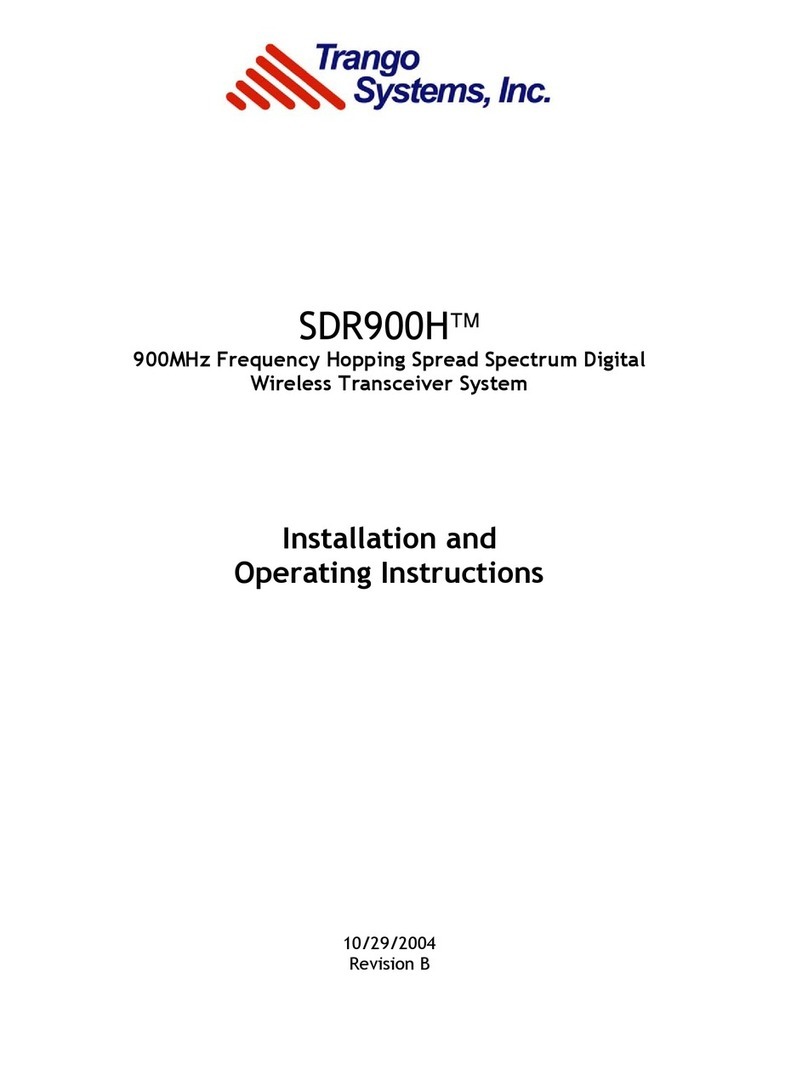
Trango Systems
Trango Systems SDR900H Installation and operating instructions

YEONHWA M TECH
YEONHWA M TECH MD Series user manual
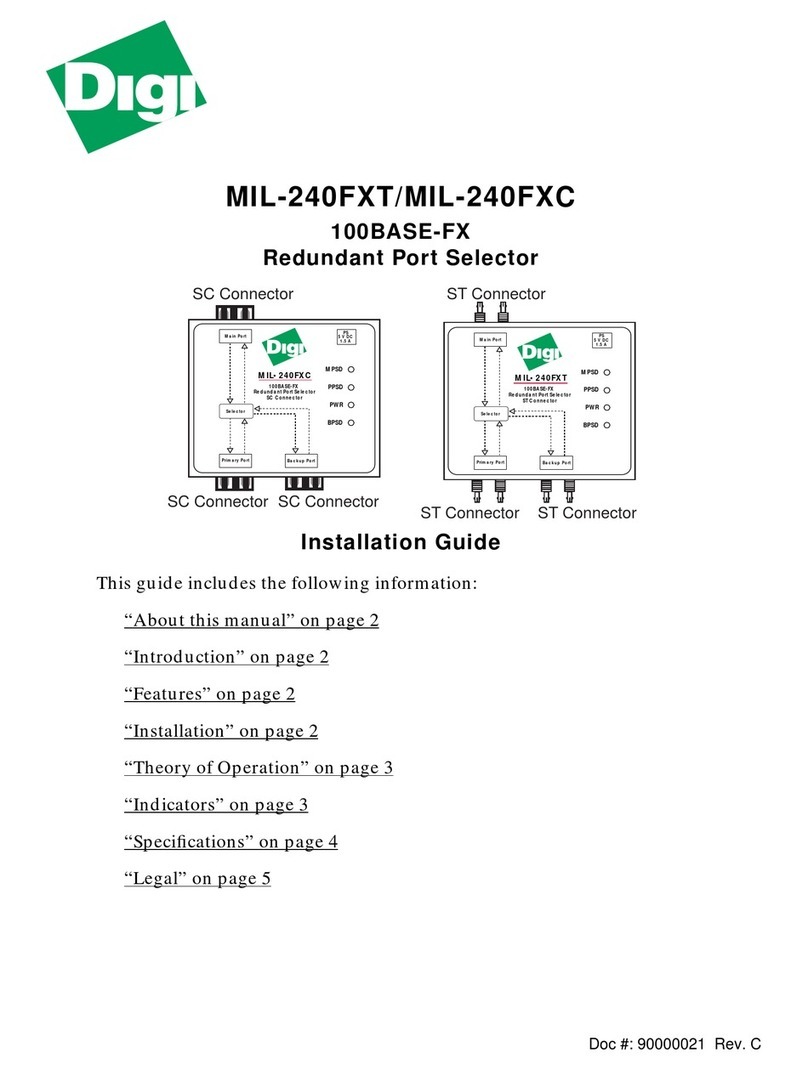
Digi
Digi MIL-240FXC installation guide
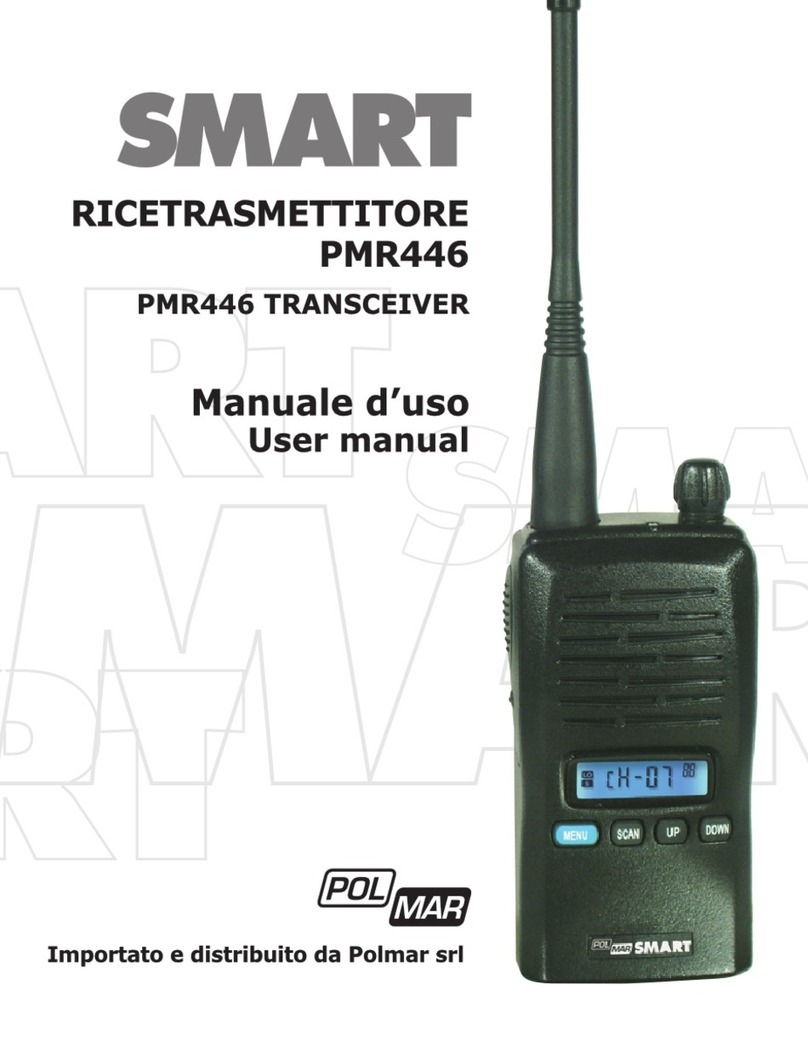
POLMAR
POLMAR SMART PMR446 user manual
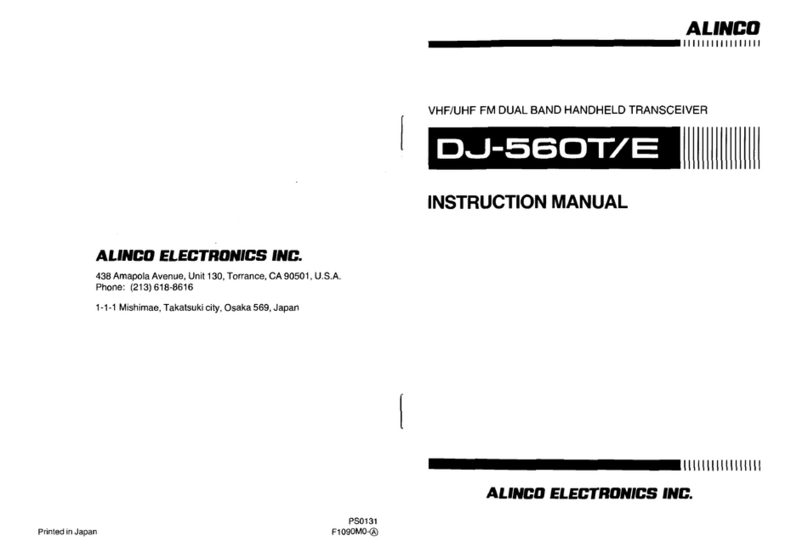
Alinco
Alinco DJ-560t instruction manual
